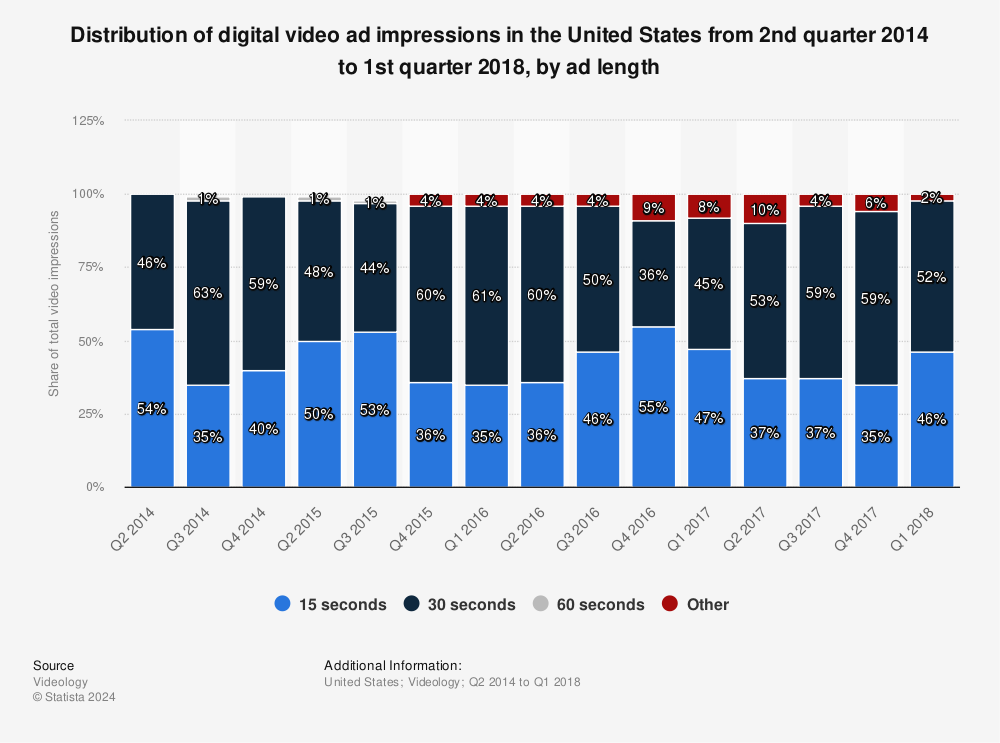For the first time this year, online video viewing surpassed linear TV. As cord-cutting rages on, US adults spend 3 hours, 11 minutes daily on online video, compared to 2 hours, 55 minutes on TV.
Global online video ad spend is projected to reach $176.60 billion in 2023, making this a great time for advertisers to start investing in online video advertising.
This guide will review what online video is, recent trends, how to measure video ads and offer some examples and expert tips.
What is Online Video Advertising (OLV)?
Online video advertising, also called digital video advertising, promotes products, services, or brands before, during, or after streaming content across desktop, tablet, and mobile devices.
The Types of Video Ads
There are many types of online video ads, making them an attractive advertising option for marketers.
Let’s explore some of the popular online video ad types:
1. Pre-Roll Video Ads
Best For: Building brand awareness
Pre-roll ads play before the main video content. When you click on a video you wish to watch, a pre-roll ad is displayed before the main content, introducing the ad experience.
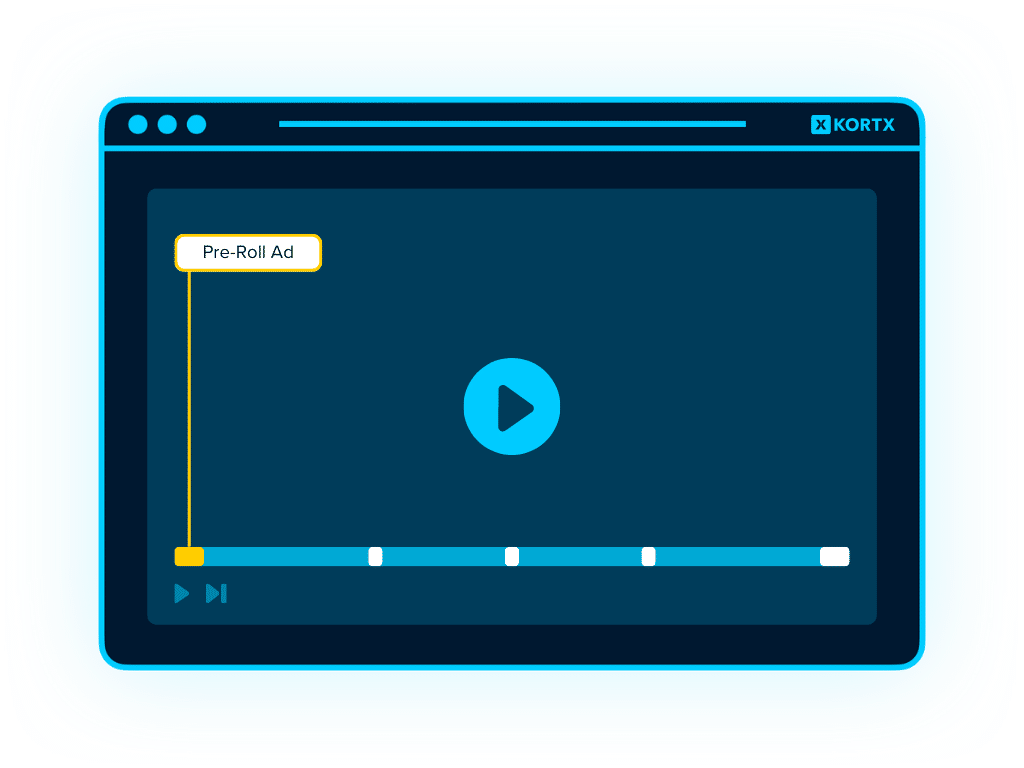
2. Mid-Roll Video Ads
Best For: Enhancing user experience
Mid-roll ads appear during the video content, interrupting the viewing experience. Usually, more than one mid-roll video ad plays at regular intervals.
Mid-roll ads tend to have higher completion rates as users are likelier to watch the ad while enjoying a movie or video content rather than abandoning it.
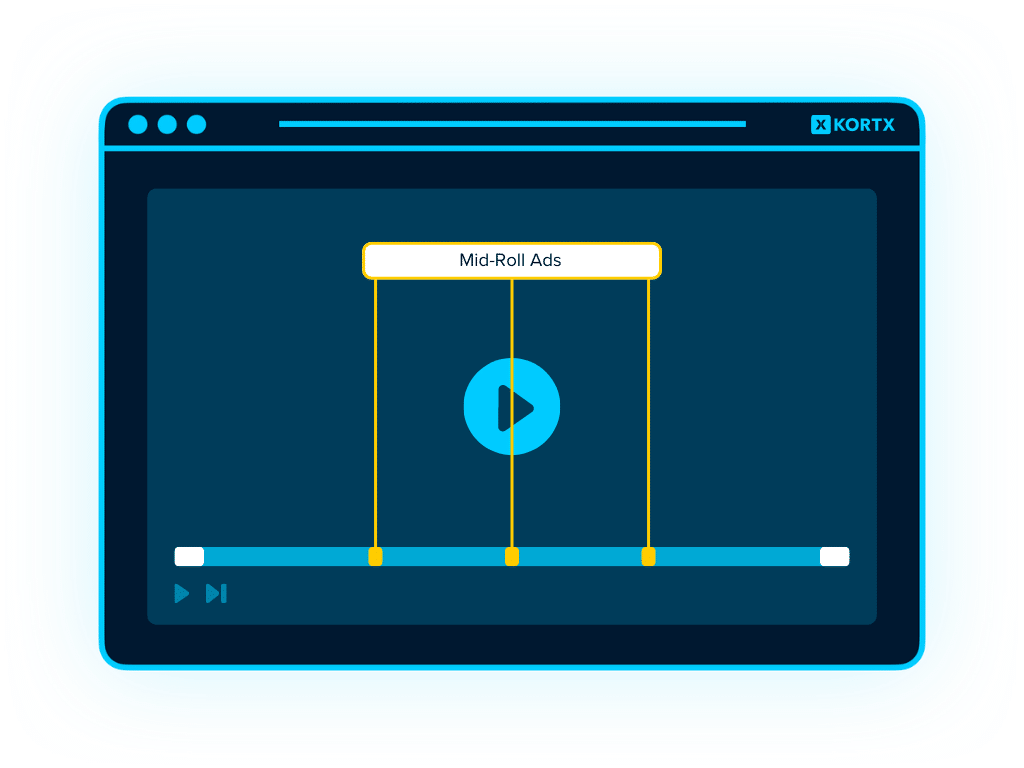
3. Post-Roll Ads
Best For: Encouraging conversions with a clear CTA (call to action)
Post-roll ads appear after a video finishes and before the next video playback begins.
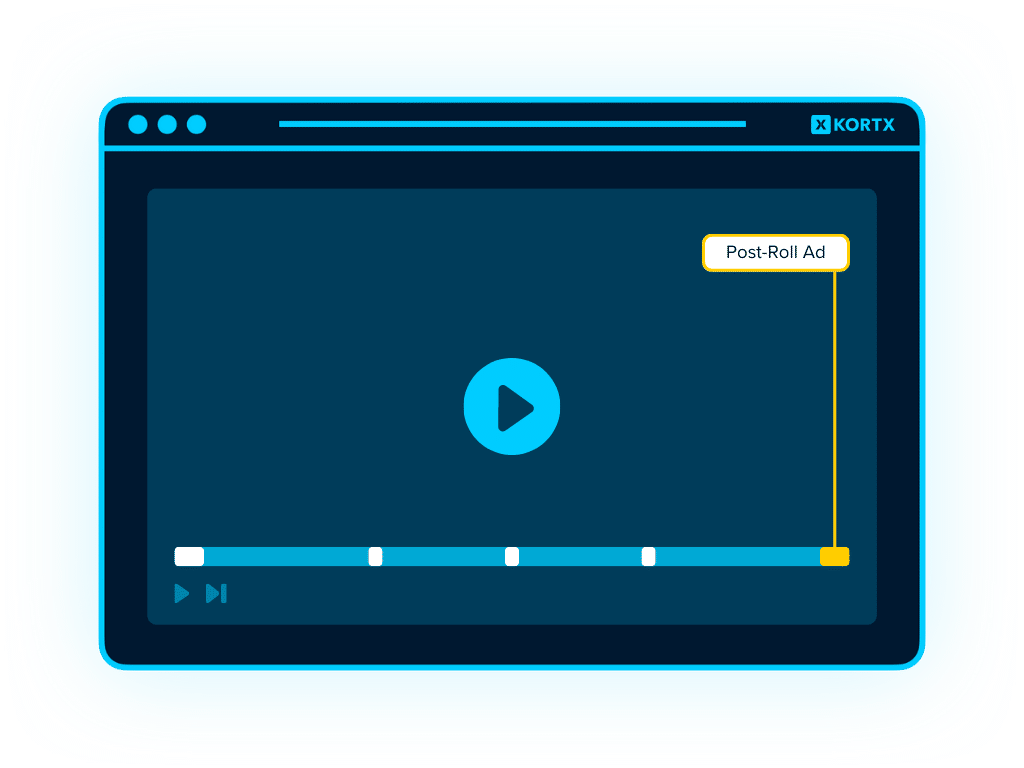
Pre-, mid-, and post-roll ads are all in-stream, linear ad formats. In-stream means the videos are played within the streaming video content, while linear means the video ads display between the video content.
Interactive Video Ads vs. Online Video Ads
In contrast to online video ads, interactive video ads allow users to interact with the ad through various components.
Like online video ads, they appear as pre-, mid-, or post-roll ads across mobile, tablet, and desktop devices.
There are various types of interactive video ads, including:
- Borders: Customizable layouts with interactive components and click-outs used for boosting brand awareness.
- Hotspots: Invisible overlays that trigger actions like pop-ups or click-outs, allowing for customer engagement.
- Shoppable: QR-code-enabled ads that redirect viewers to an app or website for app downloads or purchases.
- Leads: Includes custom forms alongside video content for lead generation, with submissions sent to a CMS or Google Sheets.
- Carousel: Showcases products or services through an auto-playing carousel with links to individual pages, best for product showcasing and sales.
- Overlay: Minimal disruption with content displayed atop the video, featuring customizable call-to-action options for growing site traffic.

An example of a shoppable interactive online video ad.
📚 Related Article: Interactive Video Ads: +66% More Engagement: This article reviews the basics of interactive video ads, including high-quality examples of using them in your online video advertising campaigns.
The Current State of Video Advertising
In recent years, video has become one of the most popular online formats, with research from Statista finding that online videos reach 92% of internet users worldwide.
Here are some additional interesting facts about online video advertising:
📺 90% of survey respondents indicated that they “Very much” or “Somewhat” enjoy watching video content from brands online.
📱76% of respondents aged 18-34 use their smartphones to watch online video content weekly.
💻 In 2022, users worldwide spent around 23.1 hours monthly using YouTube’s mobile app.
🚦 78% of marketers said videos helped increase sales.
These statistics show that online video marketing is an indispensable sales-driving medium, delivering impressive audience reach and engagement.
Online/Digital Video Advertising Trends
As upfront TV spending trends downward, falling by 3.6% in 2023, advertisers increasingly turn to online video advertising.
Let’s review the emerging video advertising trends that demand your attention this year:
1. 30-Second Video Length Reigns Supreme
In 2018, 52% of digital video ads viewed were 30 seconds long, and 46% were 15 seconds long. By 2021, 87% of digital video ads viewed were 30 seconds long, and 12% were 15 seconds long.
This indicates a growing preference for longer-form video ads, giving advertisers an opportunity to use online video ads for storytelling and additional brand engagement.
2. Heavy Preference Towards Mobile
In 2022, smartphones (36%) were the most used devices for global viewers to watch video-on-demand (VOD).
More than this, the average US adult will spend around 4 hours and 35 minutes per day consuming content on mobile devices and less than 3 hours with TV in 2023.
The smartphone dominance trend emphasizes the importance of mobile-friendly online video advertising.
3. Digital Video Makes Up For Digital TV Spend
eMarketer predicts that US upfront TV ad spending will fall by 2.6% to $18.64 billion in 2023, whereas digital video will increase 28% over last year’s numbers.
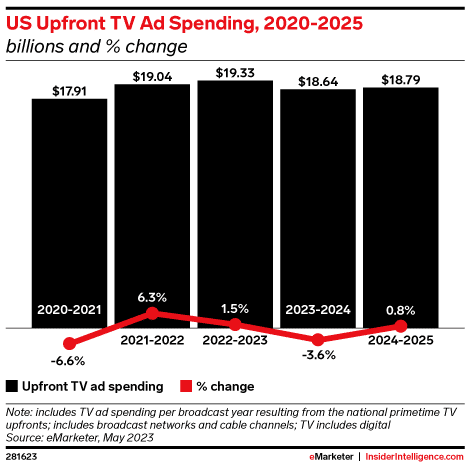
Digital now accounts for more than half of upfront TV spending, and while the digital video market is more fragmented, the trend shows a rising commitment to upfront spending in the digital realm.
4. CTV and Interactive CTV Hold Strong
Upfront CTV spending is filling the gap left by declining linear TV dollars, forecasted to grow from 30% to 40% of all CTV spending from 2020-2024.
Also, CTV video ad spending is showing significant growth compared to digital video, with a forecasted 28.5% increase in 2024.
5. More Streaming Services Will Represent the Upfronts
Apple TV+ remains the only major digital-first streaming provider yet to add an ad-supported tier, but if it chooses to do so, it will join streaming services like Netflix, Amazon, YouTube, and others in personifying the upfronts.
This reflects a departure from the past dominance of TV networks.
📚 Related Article: Branding & Chill: Netflix Advertising Guide: This guide reviews all you need to know about Netflix advertising, including how to get started.
📺 Want to Advertise on Netflix? Talk to Us.
We’ll help you find the most suitable advertising placements for your business to maximize your ad spending while achieving your goals.
KPIs to Measure Online Video
Although Video Completion Rates (VCR) and site actions may be the traditional OLV scorecard, they’re not always the best measure of success.
The metrics in your online video advertising campaigns depend on your marketing goals and whether additional tactics will support the campaign.
What KPIs do you use to measure Online Video (OLV)?
“It depends on the overall marketing goals of the advertiser and what other tactics we layer to support their OLV initiative. In some instances, we have witnessed remarkable success by simply focusing on delivering the ad to a specific niche target audience without optimizing towards specific metrics like VCR, CTR (Click-Through Rate), or conversion rates.”

The Advantages of Online Video Ads
Online video advertising offers numerous advantages for businesses looking to engage their target audience in a new way.
1. Video Ads Are Visually Compelling
People are highly visual, relying heavily on visual cues for various parts of our daily lives. Video content capitalizes on people’s preference for visual stimuli, making it highly engaging and captivating for viewers.
Platforms like TikTok and Facebook have shown that video ads have better engagement and higher video completion rates, successfully capturing and retaining viewers’ attention.
2. Video Ads Are Highly Versatile
Online video ads can adapt to different marketing funnel stages. As audiences move further down the funnel, you can adjust the video messaging to align with their evolving needs and preferences.
- Upper funnel: you can use OLV ads to create awareness, establish brand identity, and generate interest among viewers.
- Mid-funnel: engage viewers, providing more detailed information about the product or service and nurturing their consideration.
- Lower funnel: you can shift towards optimizing for site actions rather than video completion rates, encouraging users to click through to a website, engage with your offering, or even make a purchase.
Also, online video advertising provides flexibility in video format and length. Short, snackable videos of around six seconds can capture attention quickly, while long-form content can be used to tell immersive stories or deliver in-depth information.
3. Video Ads Can Increase Message Retention
Insivia found that viewers retain 95% of a message when they watch it in a video compared to 10% when reading it in text. This is great news for advertisers using online video ads.
Online video’s dynamic nature means you can deliver a compelling narrative, helping you convey your message and increase the chances of people remembering it.
3 Examples of Online Video Advertising Success to Inspire You
Below are three examples of how brands use online video advertising to achieve their objectives and drive impressive results.
1. Trustmark Bank x KORTX
In this campaign, we helped Trustmark Bank implement a full-funnel strategy across Video, Display, Audio, and Connected TV to target the identified audience.
Challenge: Trustmark Bank needed to generate qualified leads in new and existing branch locations across multiple lines of business while optimizing their marketing strategy and budget.
Strategy: KORTX used Axon Audience Manager to analyze customer data and uncover previously unknown interests and behaviors. A full-funnel strategy was implemented across Display, Audio, Video, and Connected TV, with Captivate Rich Media units driving users to branch locations.
Outcome: 98% video completion rate, 90% listen-through rate, and a 0.20% click-through rate.
2. Large Furniture Retailer x KORTX
For this campaign, we helped a large furniture retailer optimize their online video campaigns by replacing their original metric (VCR).
Challenge: A large furniture retailer’s online video campaigns focused on Video Completion Rate (VCR) without considering the correlation with sales.
Strategy: KORTX implemented on-site tags to measure site activities and optimized for VCR while attributing a positive Return on Ad Spend (ROAS).
Outcome: Removing the VCR goal led to a 202% increase in ROAS, as the algorithm prioritized delivery to the target audience, expanding the pool of potential site-side converters.
3. Quinnipiac University (QU) x KORTX
KORTX crafted a campaign using various media channels, including Online Video, Display, Social Media (Facebook/IG/TikTok), Rich Media, Connected TV, and YouTube.
Challenge: Quinnipiac University (QU) aimed to address shifting Gen Z attitudes towards higher education and improve undergraduate recruitment.
Strategy: QU partnered with KORTX to develop an audience-centric digital advertising strategy, leveraging personalized messaging and a comprehensive campaign across multiple media channels.
Outcome: The tailored approach resulted in over 6,000 applications, surpassing expectations, with a cost-per-application of $125 and an average of 1,500 applications per enrollment period.
✨ Tips for Successful Online Video Advertising Campaigns
To make the most of your online video advertising campaigns, we’ve compiled a list of our best tips to drive better results.
1. Test Different Ad Lengths
Experiment with 15- and 30-second ads and test various lengths to find what performs best for your target audience.
Shorter ads (30 seconds or less) tend to have higher performance, so consider using a mix of lengths and conduct A/B testing to determine what length works best with your audience.
2. Keep Your Creative Fresh
Continuously refresh your ad creative to avoid viewer fatigue and maintain audience engagement. Stale or repetitive ads can lead to decreased interest and less effective campaigns.
3. Rotate Ads on Social Media
Switch out your paid social video ads every 4-8 weeks to prevent ad fatigue, especially when targeting the same audience repeatedly. Fresh content helps maintain interest and avoids viewer indifference.
4. Align Messaging and KPIs with the Marketing Funnel
Tailor your video ad messaging and Key Performance Indicators (KPIs) to align with different marketing funnel stages. Customize your approach based on whether you aim for awareness, consideration, or conversion.
5. Utilize a Tactical Mix
Consider beginning with display ads as an entry point to attract initial attention, then incorporate online video ads for versatility and visual appeal. Video elements are highly engaging, making them a great medium for capturing and retaining viewer interest.
Advertise With Online Video Ads Today
Online video ads present a compelling and versatile option for brands to engage their target audiences at different marketing funnel stages.
As online video viewing surpasses traditional TV and global video ad spending steadily rises, now is the best time for advertisers to invest in online video advertising.
Want to learn more about online video and CTV advertising? Read more:
Captivate Your Audience with Online Video Ads.
Use our expertise to maximize your reach, engage your target audience at every stage of their journey, and confidently achieve your goals.
Drew Pytel is a Senior Account Strategist at KORTX. He enjoys golf, bourbon, and being active with his wife and 3 kids.

